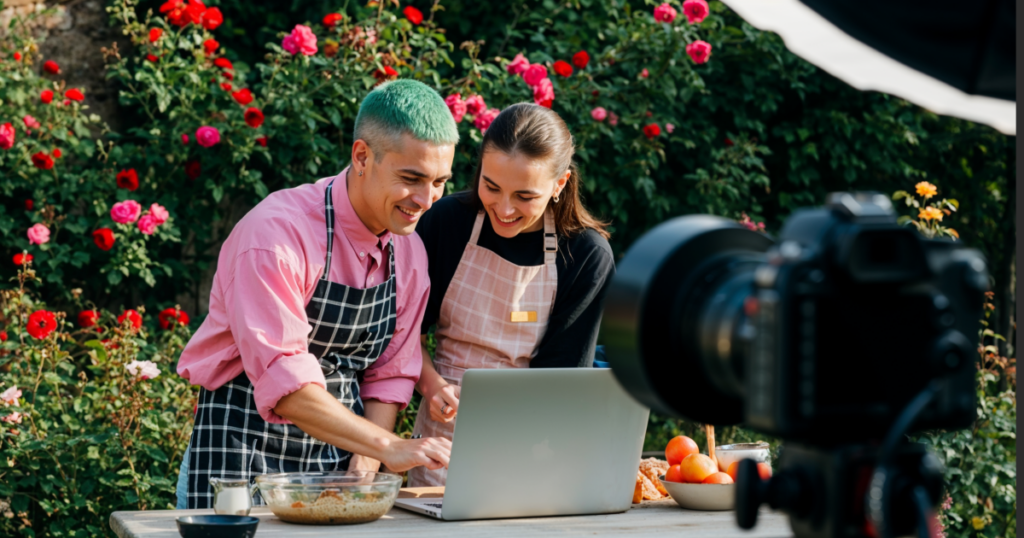It’s time to get real — you’re posting fire content on your Instagram and all eyes are on you, but if you’re not cashing in, you’re leaving money on the table. Your feed is filled with quality content and you haven’t taken any shortcuts; you’ve built a goldmine. Don’t just collect likes and follows — get that bag, too!
We’ve shown you the secrets behind how influencer income growth actually works by introducing you to the standard income streams for influencers, how to prepare your personal brand for partnerships, and how to keep your money flowing.
Today, we’re going to dive deeper into actionables for how you can find and secure deals and build long-term success. If you’re willing to put in the work beyond just creating content, you can turn clout into cash by crushing your presentation, finding partners that actually want to work with you, and closing bigger deals. We’ll even share how the big players expand their revenue streams in new directions.
First, You’ll Need to Nail Your Media Kit
A media kit is what the marketing industry calls your PDF pitch — it’s typically 2-4 pages all about you, what sponsorship or collaboration opportunities you offer, what it costs, and what their ROI (return on investment) is. Influencers use media kits to secure partners, but so do news organizations, bloggers, and events seeking sponsor dollars. The language is fairly standard, so if you offer someone your media kit, you shouldn’t have to explain what that is.
If you already have a logo and brand colors, you’re ahead of the game. If not, it’s a great place to start as you take this professional step forward. Canva is an option for creation, but if you can afford to have a professional graphic designer assemble this portion of your brand (OR the entire media kit), that’s ideal.
Whether you DIY it or go the professional route, let that logo and color set drive your media kit creation. Search Canva templates for media kits and you’ll see tons of options that will inspire you — then, go choose one and prepare to customize it. We highly recommend paying for a Pro account, even if it’s only for one month, so you don’t have to worry about any feature restrictions.
As you select your template, think of words that describe your brand — are you earthy and ethereal or polished and poised? Try using some adjectives when you search for media kit templates to help narrow the options.

Once you’ve chosen your aesthetic, start adding as much information as possible. Don’t worry about what’s in the template; it’s just a starting point. Concise language is going to be your friend, as are power words.
Think like a marketing executive and answer all pain points before they come up — if someone is going to give you money, this is your chance to explain what a fabulous idea that is. But words aren’t enough. You have to give data.
This is where Instagram Insights comes in — anyone with a creator or business account that has over 100 followers and has been on Insta for over 90 days has access. All of your available data is right there. Demographics like geography, age, and gender tell people with marketing budgets who is absorbing your content, and if it matches the people they’re trying to sell to, you’re winning!

Marketers also want to know any analytics that you have — is your content becoming more relevant? Are you gaining traction? Are your likes and views going up? Have you found unique success on Reels, for example? These are all marketable.
If you’ve ever partnered with anyone before, use them as an example — what did they get out of the partnership, did they say anything positive to you about the partnership? Can you get a testimonial from a past sponsor that boosts your marketability? This strengthens how much you can command.
Speaking of command, it’s time to talk about your offerings. No one is just going to give you money with no strings attached, they want specific eyeballs on a specific product, and you’re a conduit. How are you interested in doing that? What is your specific value proposition? Do you want to allow brands to pay to be reviewed honestly in a 15-second Reel, or do you want to go to events as an influencer and promote it in advance to get more people there? Would you prefer to do giveaways, co-create custom content, allow an Instagram Takeover, a simple brand shoutout, or Instagram Lives?
The range of options is vast. So is pricing. This is where it gets tricky because an ultra-niche influencer, like someone promoting clothing for folks in wheelchairs, can charge more than someone in a broad category like general fashion. An influencer with millions of followers can also charge more than a micro-influencer with thousands. There are two schools of thought on this: (1) always charge more and focus effort on the big fish, or (2) start small with a static sponsored Reel for a few hundred bucks, over-deliver, and earn repeat business. The second tends to be more successful in this industry.

There are also two schools of thought as to where to put your media kit. Some believe it builds mystique to keep it private and available upon request, giving it a feeling of exclusivity like a luxury brand. Others believe it builds trust to have a media kit publicly available as a way to be transparent and earn trust. There’s no right answer here, so go with your gut.
Ultimately, to pull this off, you’re going to want to revisit your media kit frequently — it’s where most influencers screw up by doing the work once and calling it a day. Add a calendar reminder for every 90 days to go in and update your analytics and demographics, add more success stories, and reconsider your offerings.
Pro tip: If you’re going to have a price increase in the future, it can potentially help close more deals now because of the buying pressure (plus FOMO).
Your Media Kit’s Done, Let’s Go Find That Cash
You’re probably researching monetization because you’ve gotten the ol’ “hey, we love what you’re doing, can we send you a plastic mug for free to be featured in your next Reel?” or “your brand is fire, we’d love to give you a few cash monies to mention us,” or “let’s collab — we have similar audiences and we don’t wanna pay anything, but you might get some new followers” direct messages.
That’s typically how it starts. You may have even experimented with some of these partnerships and realized that if this is what’s falling in your lap, what’s out there if you actually went out and asked for it?
Your first big step is to put yourself out there — think back to any brand that has ever reached out to you, even if their offering was offensively small. There might be a budget to work with, ya never know. Send them a kind note reminding them that they reached out to you a few months ago and your account is currently blowing up — you’d be happy to connect to see if they’re in a position to take advantage of the opportunity.

Also reach out to anyone who you know in a marketing job. They might not be a decision maker, but there’s nothing wrong with sending a media kit asking if they think it would be interesting to anyone in the company, and a kindly worded request to be passed along to the person who would manage that type of relationship.
Next, you’ll put yourself out there by listing yourself on one of the influencer matching sites — there are plenty these days, so spend a little bit of extra time zhuzhing your profiles on these platforms. Unless you’re super niche, it might never lead to anything, but it’s worth a shot.
So all of that so far is considered marketing to warm leads. They know who you are before you have your first conversation. It’s the most comfortable type of outreach. But you’re goin’ places, so let’s take a step into the cool, cool waters of cold leads — people who may not know who you are or care what you’re up to.
It sounds scary, but before we even get started, please know that if you send out 100 messages to people who don’t know you and 10 respond, you’re doin’ well, and converting 1 is a win. It sounds like a lot, but cold leads are tough. But remember: You don’t get what you don’t ask for, so let’s get to asking!
An easy way to reach cold leads is to deep dive into who is spending money with your competitors through ads or collabs. And if you don’t prefer to think of folks as competitors, that’s fine, just look at who similar creators are being sponsored by. DM the brand directly, and if they’re too big to likely answer, see if there are any staffers interacting with your competitor’s content — DM them. Don’t just send your media kit; let them know you’ve noticed they’re reaching out to Instagram viewers and you’d love to discuss partnering to explode their ROI.
After you have all of those plates spinning regularly, you’re going to wanna get a LinkedIn pro account, even if you can only afford it for a month, so you can direct message any user. Whatever language has been receiving any responses can be reused here, and this is where it is appropriate to also include a link to your media kit, so they can determine if they’re going to give you the time of day.

In marketing, the person who would have the budget for working with you comes with nearly 8 billion zillion job titles, but here are a few to search LinkedIn for at the companies you’re targeting: Influencer Marketing Manager, Brand Partnership Manager, Marketing Manager, Marketing Director, Collaborations Manager, Media Buying Director. Manager and Director are the standard titles at that level. You can reach out to a CMO, but most companies have a specific order of partnering with brands, so I recommend sticking mostly with the Manager level.
Additionally, companies that leverage major events will often be some of the big brands that have current budgets (especially during a tough economy). Look at the large industry events that pertain to your specific niche and see who the sponsors are, find them on LinkedIn, seek out their Influencer Marketing Manager (or any of the titles above), and give it a shot.
The theme here is “give it a shot.” Trust me; influencers do infinitely more asking than receiving. Even if it’s uncomfortable, it’s worth the effort, not just for financial reasons but for growth.
Pause to Think Outside of the Box
Where many influencers fail is they find a formula that works, even if not well, and they repeat it. They send the same message to the same types of people, with the same ask. Over and over.
Avoid that by opening your eyes to what others in your space are doing — you don’t have to reinvent the wheel and you don’t have to copy it, but you sure as hell should at least use it instead of ignoring it.

Instead of taking that same ask to the same people, consider related products and services that aren’t as saturated in the space. If you see Nivea Micellar Water sponsoring all of your competitors, reach out to them with why you’re different, but also go after Pond’s and Clinique. Think about related products like toners, serums, sunscreen, exfoliators, and providers that perhaps specialize in those related products. This is how you expand your partnership pool.
Consider in your initial outreach pointing out that Nivea Micellar Water is already sponsoring all of your competitors, but you’d like to partner with brands more like theirs (and be specific — perhaps they’re anti-animal cruelty or vegan or low-waste).
Put thought into your strategy and don’t just go after fast cash; consider bundling your offerings for partners and offering better deals for brands interested in entering long-term partnerships with you. It may mean less money upfront, but definitely more secure cash flow in the long run.
Think outside of the box by considering co-creation as well — if someone’s creating products or services that you know you could help with, or in cases where you could both benefit from working together, reach out. For example, if you do real estate content about luxury homes, study the big aggregators, but don’t forget the lesser known search sites. What are they creating that is similar to yours (but shh, maybe not as good as yours), that inspires you to co-create some content together? Reach out and let them know.
Lastly, there are always non-monetary deals like receiving free products or services. Maybe a company wants you to review their fancy mattress, but they don’t want to send cash — would you say yes? If a brand wants to send you on a free trip to Bali to review their hotel and talk about your trip, would you say yes? You don’t have to wait for them to reach out to you for what’s called “in-kind” promotion, just use the same cold outreach methods you’ve been using and switch up the wording a bit.
Make Sure You’re Actually Closing Deals
Cashin’ checks isn’t about sitting still and letting things come to you. Closing deals is about understanding what people need and how you can provide it for them. Negotiating is about getting to a yes (in fact, there’s an amazing book that everyone in business should read by that very title).

Spend time pricing your packages effectively — a great method for discovering if your pricing is right is to simply ask. Often, being told you’re too expensive doesn’t actually mean you’re too expensive, it’s a polite brush-off. So instead, ask partners after you’ve established an ongoing rapport — would they have paid more or was it honestly a stretch? After a deal is done, honesty sometimes comes out (and sometimes doesn’t). Surveying partners afterward and including a question about pricing is helpful to learning how to price properly.
You might be tempted to simply accept payment and slap something up on the internet, but contracts exist for a reason — be protected. Google search “influencer marketing contract template” and choose the platform that resonates with you — boilerplate language is fine at first, but do try to have an actual attorney review your contract before you get too far along.
All contracts need to have start and end dates, clarity on exclusivity, an outline of the offering (what, when, and where content will be posted), usage rights, any intellectual property reservations, and payment terms. It doesn’t have to be a long document, but cover your bases and show your partners that you’re interested in professionalism, even if your channel is something goofy.
Professionalism extends to your communication — let your points of contact know when a contract is executed, a payment received, or a sponsored post has gone live, and track campaign performance with analytics, communicate ROI with testimonials and post-campaign reports.
Pro tip: Go the extra mile and head back to Canva templates to make visually appealing reports.
Even if no one asked you to report in, do it frequently to keep yourself accountable and over-deliver to foster loyalty. This will help you to ensure repeat business.
Find Those Hidden Stacks of Money
Once you’ve gotten a hang of all of that (regular outreach to potential partners, over-delivering to existing partners, all while still creating and marketing your content), you’ll be ready to graduate to finding the hidden cash.
It becomes time to think beyond sponsorships and collabs.
Some will have a well-established audience that buys anything they talk about, so they jump on affiliate marketing to get a cut of all sales. Others will get into digital products like webinars, courses, and e-books either about the topic they’ve established expertise in, or how they did something specific to get where they are.
Subscription-based options like Patreon (or, uhh, OnlyFans — no judgment) are also appealing to some niche creators to peel off their existing audience into something more lucrative that runs parallel to what they’re doing.
You might also consider getting into e-commerce through printed merch to support your brand or even physical products (CPGs — consumer packaged goods) like cosmetics with your name on them. Partnering with companies that need up-and-coming names is more than just having a post to put up; sometimes they want your name literally on their product as well.
Other creators dive into licensing their content to a brand (which is known as whitelabeling), especially if there is an educational component to it, so they may use the content internally and put their name on it.
Finally, there’s also hidden money in simply expanding current content into related formats, like adding a YouTube channel to support the Instagram content or “behind the scenes” email newsletters that are monetized. Diversifying formats, adding extra info through other means, and reusing content effectively are common ways more money can be uncovered, so go uncover it!
It’s Your Dough, Now Go Get It
By developing a badass media kit, starting the nerve-wracking practice of reaching out to brands that might not know you, practicing professionalism and thorough communication, answering a client’s needs, and refining your strategies to leave less money on the table, you’re gonna slay as a creator. It’s your dough, now go get it.






